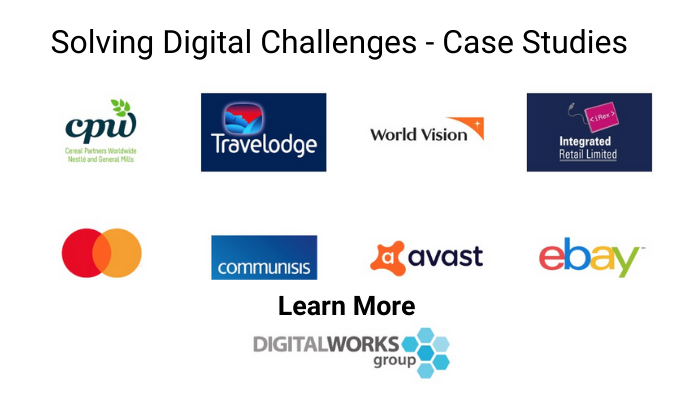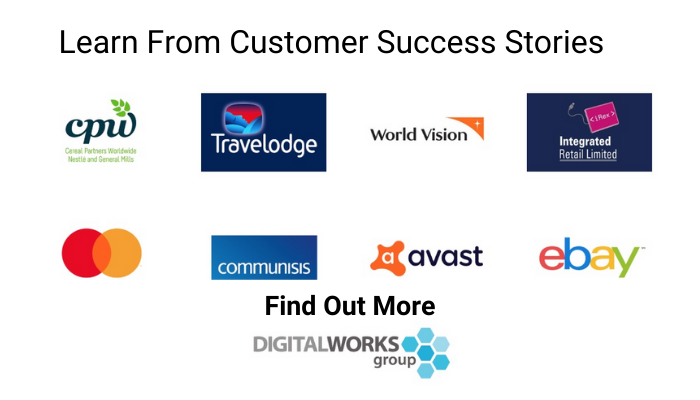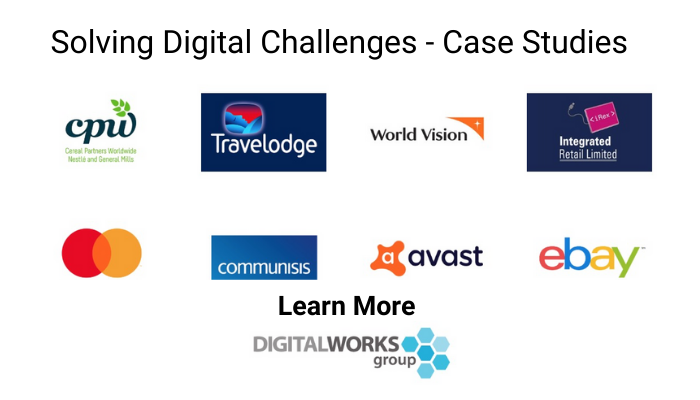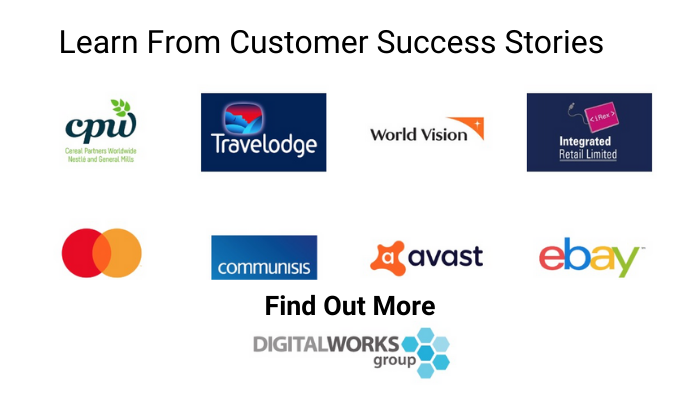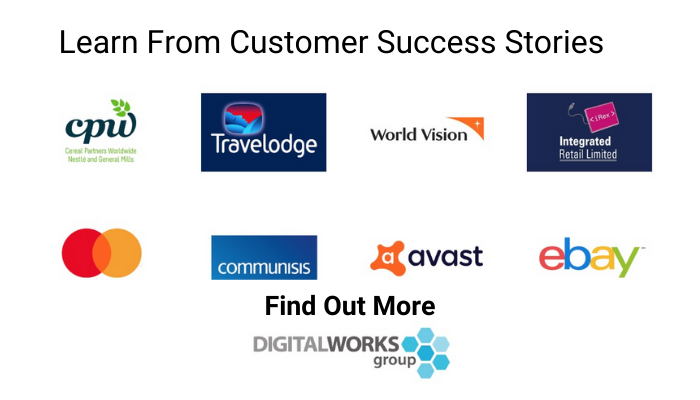Controlling and delivering Digital Transformation can be a challenge! In this business education webinar, Digital Transformation expert, Andrew Salmon of Digital Works Consulting, shares his experience, recommendations and best practices to help guide you through your transformation journey.
Andrew shares some top advice on how to control and successfully deliver digital transformation.
Transcription
Andrew Salmon: Hello everybody. Thank you very much for your time and coming along today. Just to give you a bit of background. I’m one of the Senior Partners at Digital Works Group. We’re a business transformation, innovation consultancy and have come across the challenges and also the benefits of going through digital transformation.
Hopefully today we’re going to share some of our experiences and some of our expertise.
I’m going to use this deck that we have put together just to guide the webinar. We’re going to talk about how you go about controlling change when you’re going through a transformation, or even a turnaround situation. Secondly, we’re going to cover the importance of getting collaborative, cross-functional working relationships. Two really important things as you will see as we go through the webinar itself.
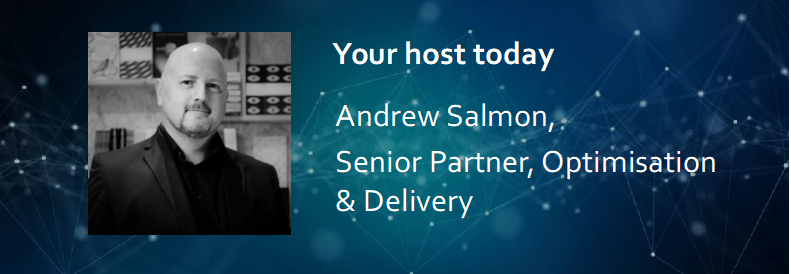
A little bit about me. I’ve been in digital for 25 years and I’ve worked for some fairly big organisations, fairly well-known ones. Let’s call then ‘Web One companies’; like Compuserve, AOL and Freeserve, all the way through to organisations today who are going through either turnaround or transformational, game-changing innovation type of activity.
My background is ‘digital’ but also in ‘change’ at a relatively senior level within corporate environments. I’ve been through these kinds of challenges, not from a consultative perspective, but principally from somebody who, within an organisation, needs to go through it. That’s, I think, a very useful reflection point. This is what we’re talking about today. Some of it might have come out of a book, but the majority of it has been learnt through practical experience.
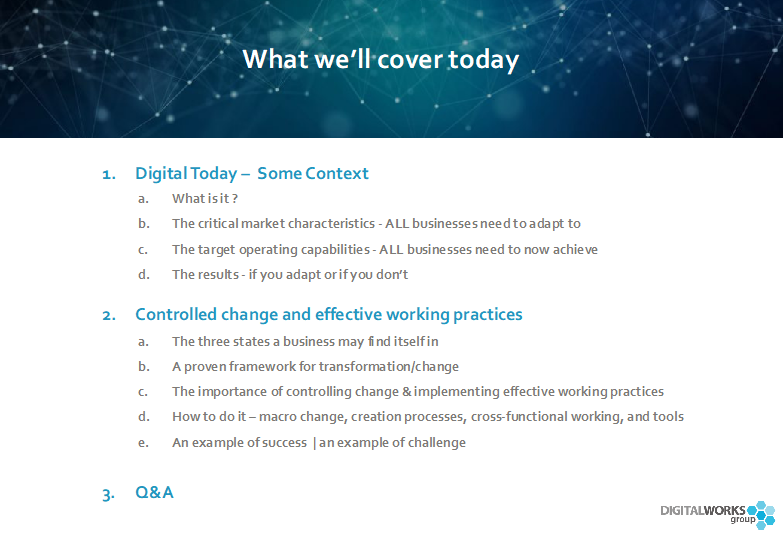
So firstly, we’re going to give some context, which is really important. What it fundamentally does is cover today’s environment and what we need to adapt. The second bit is about our experiences but also what we’ve found to work when you go through the challenge of controlled change, and in needing to inject effective working practices.
We’ll be talking about the three states: turnaround, transformation, and innovation, but we’re going to focus very much on the ‘transformational’ stage.
We’re going to talk very briefly about a proven framework that we use as an organisation to make change smoother and faster. Then we’re going to talk about the importance of controlling it and implementing effective practices:
- How you do how you control the macro change?
- What creation processes you need to inject?
- What types of cross-functional working practices should you use?
We’re going to share some information on tools that we have come across and like that we think can help. Then we’re going to give some examples of success and then also an example that was producing some challenges for a CEO.
We’re not going to say the name of the organisation because that would be embarrassing, but we can tell you the context and some of the things that they were facing at that particular point in time. Finally, Q&A.
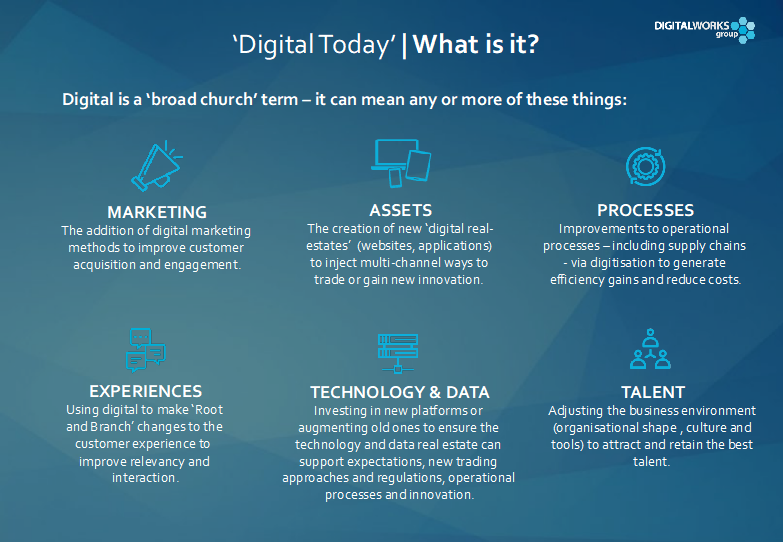
So I always start with this. If you’ve attended one of these webinars before, I apologise, but it’s really important to kind of stress this, okay? Digital today is a really broad church term, it’s actually fairly meaningless.
Let’s just say in this case, it’s the ability to use technology to become better at matching new behavioural change in people, and doing so because of their adoption of their own technology.
It can affect a number of areas. It can produce benefits and the way you do marketing through PPC SEO, through your assets (e.g. your web assets, your mobile applications) and the way that you create a multi channel experience. The way you digitise your internal processes to make them more efficient and your end-to-end experience because today unfortunately most humans are now really demanding.
They are very time poor and frankly want a very joined up, multi channel, multi device, highly personalised, highly relevant experience which benefits and actually matches their needs. Experiences today are really important. The ability to adapt to that with digital is clearly an important part but it isn’t just the answer. It’s part of the mix.
Obviously, technology and data needs to operate and change. Data is really, really important these days because it’s the fuel for risk management, to personalisation, to everything else. Your technology stack is the way to enable that in a very efficient and effective format. Digital and IT are synonymous.
Final thing, obviously, is to do with talent. We’re all humans and we’ve all changed. I’ll talk about that in the next slide, but fundamentally, when we’re at work, we’re human beings and we need different experiences. It might be different ways of working, it may be different tool sets that we’re looking for. especially if you are ‘a digital native’, or maybe a ‘millennial’. Their demands, their way of working and what they’re expecting, is very different today
‘Digital’ covers all of those things, including elements like supply chains and your processes. So that’s a very broad explanation of this ambiguous term, at times, called Digital.
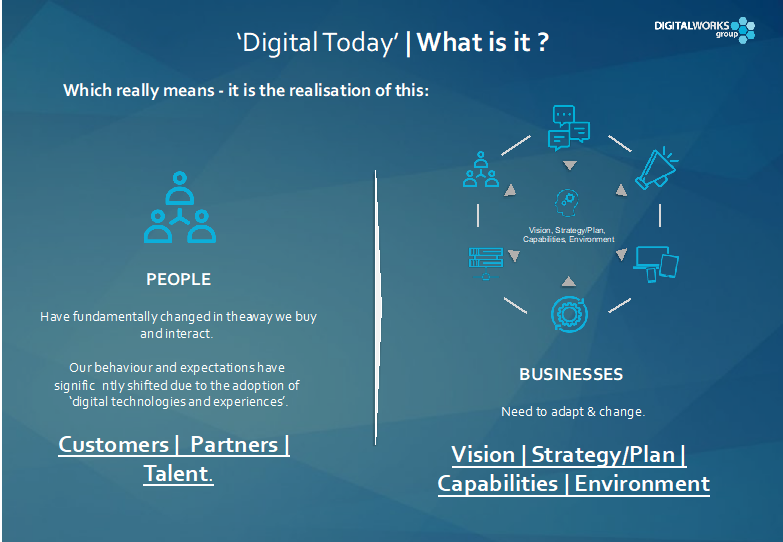
So what that boils down to, is this. People on the one hand, whether they are a consumer, or a buyer from another business or their talent, have just changed. Their expectations have changed quite significantly over a period of time. It has been relatively rapid over the last 20 years.
The adoption of the mobile phone has changed our way of operating in buying cycles, quite significantly. In the past when we walked into a shop, we would look at a price and we might have said: “the offer price is fantastic, we’ll buy now”. Now, a lot of us go, “well, let me check to see if I can get that somewhere else more cheaply”. For a consumer, it’s very empowering!
Organisations have to adapt to this (this is marketing 101). You do that through all areas of your businesses, from marketing, technology processes, customer experiences, and all those types of things. It needs to be encompassed within that clear vision and strategy plan and enabled in your capabilities.
What’s really clear is that businesses have to adapt to changing behaviours and expectations of people. If they don’t do that, they will be disrupted. Digital isn’t just one of the disruption points, regulation is another one. But if you don’t adapt, fundamentally you will be disrupted.
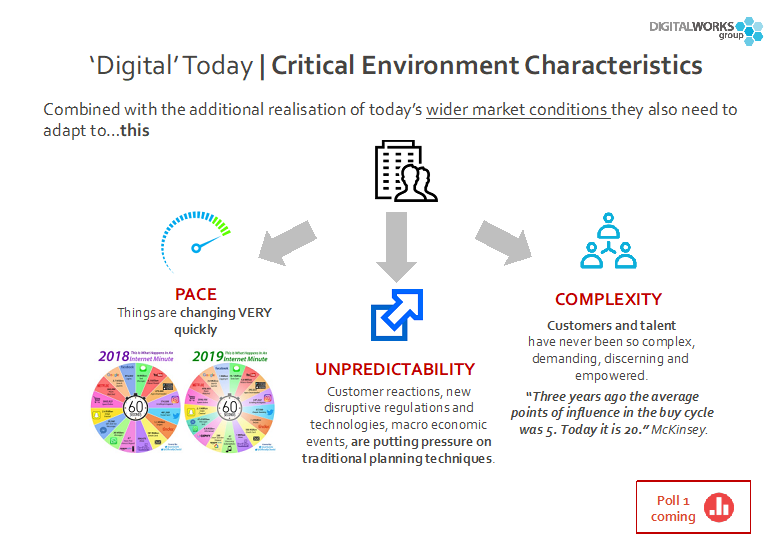
Another thing to obviously be aware of is the macro environment and the general characteristics of what the markets are like these days. Although this is possibly more pertinent for a consumer market, this is equally starting to develop in b2b markets as well.
The core characteristics are changing rapidly. Businesses need to be able to adapt really quickly. It’s really unpredictable. I mean, we’re living in a highly, at the moment, unpredictable phase of the world. Brexit is one of those things but so are macro economic events, such as what’s happening between the US and China at the moment.
It’s really difficult to be predictive and therefore, the old techniques of how you potentially would do traditional planning, are clearly under threat, because you can’t really look five years out with any degree of clarity these days. In fact, for a lot of organisations, I would say, being able to look a year out is pretty challenging these days. So you have to do things in a slightly different way.
What we’ve also said already is that it’s more complex than it ever used to be. In the buy cycle, people look for information to be influenced to buy stuff, and so it’s extended quite significantly over the last few years. So if I’m now being an effective company, trying to sell things to people, I now have to look at all of those elements. You know, five or so years ago it was five things. Now it’s twenty twenty plus.
Clare, I think we’ve got a poll coming up? Just to ask the audience. Are you able to launch that?
Clare Carroll: Sure, here we go. Here’s the question for you. What percentage of consumers use more than one channel during their shopping journey? It could be 42% 57% 73% or 86%.
(Audience voting in online Poll)
Andrew Salmon: Clare. I think I’m right in saying it’s 73%.
Clare Carroll: That is correct.
(Poll results shown)
Everybody well done for recognizing, it’s clearly a lot! It’s become more complex in the way that people operate when they’re buying things. That (poll) just demonstrates that. So not quite 86% but very shortly that will undoubtedly be the case. Today, 73%. For those people who thought 57%, it’s moving and is more complex than perhaps what you’re anticipating? Thanks for doing that everybody, just going to close that poll down.
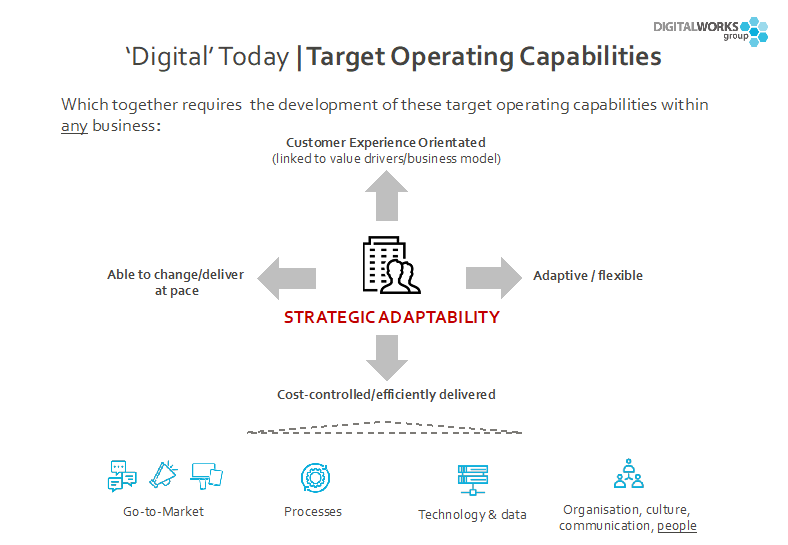
If you have those type of characteristics not only with your customers, but also in the broad environment, you’ve got to try and create a certain set of target operating capabilities. Now right at the heart of that is to build the capabilities into your business so you become strategically adaptable.
What does that mean? Fundamentally it means that you can react, you can move quickly, you can do the right things at pace. It means you are very customer experience orientated and they are linked very clearly to specific value drivers and business model requirements. So, you put those two things together, and you get the right roadmap or the right path of activities that you need to do.
You create capabilities in your organisation so you’re adaptive and flexible. Underpinning that, it’s all cost controlled and efficiently delivered. You do that through all areas of your business, whether that be: ‘go to market’, in your processes, your technology and data and most importantly, it’s probably your humans because they’re the most challenging element to get right.
But if think about those customer changes and the macro economic environment, these are the capabilities with the target operating capabilities that need to be within organisations today.
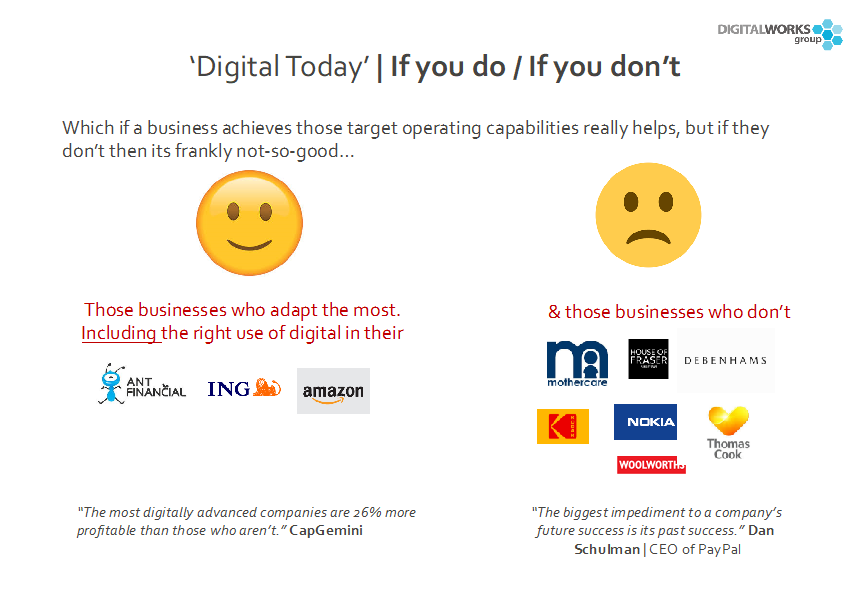
I’m not going to dwell on this too long, but it’s really clear some companies do it and some companies don’t.
There are a number of organisations on the left hand side that I am that particular fan off. Everybody will hold up Amazon all the time, ok, so let’s not talk about them. Ant Financial, a big Chinese financial services FinTech business, has an amazing amount of transactional capabilities. They refresh their technology stack every four years so they can continue to do the right things in the market and they’re flexible and able to change at pace. They are amazing!
The other one is ING. We’ll talk about ING very briefly as I’ve cheated somewhat because I’ve given you a link to a video later in the presentation that I would strongly recommend you look at.
We hold them up as an organisation, which has actually got to, what I would call (because there’s never an end state) a very, very mature state in the way that they operate. They control change and the working relationships within it. The video explains it far better than I can. But, we’ll talk about that later.
On the right hand side, there’s some names we all know who frankly haven’t made it. They didn’t adapt to the conditions and that’s not to talk about how much digital but they didn’t adapt quickly enough to the environment that they were facing, for whatever reason that may be.
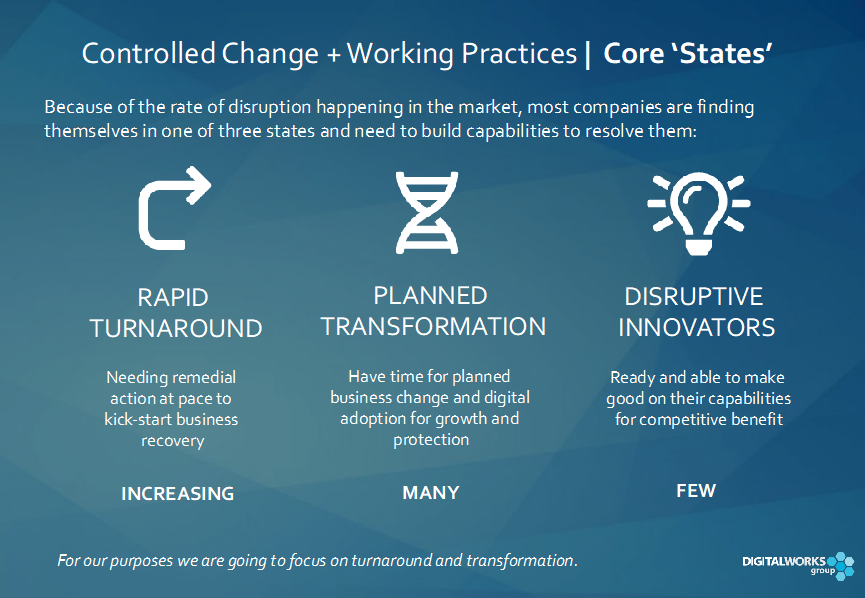
Because of all of the disruption happening, you’ve broadly got organisations fitting into three states today. The first state is requiring ‘rapid turnaround’. They haven’t seen the disruption coming quickly enough and now they need to change what they’re doing at an amazing pace.
In those cases, there’s a big fire operating within the business and they need to put it out and there’s a certain way to do that. Usually, it’s the way that you would do a planned transformation, it’s just sped up.
The second one is organisations who can see the disruption coming. Typically, a very good business with a really good management team and they can see it coming. They need to change their organisation to get target operating capabilities and other stuff into their organisation to make that change, faster, smoother and less risky.
The final state is for those brilliant companies who have already got there. They fundamentally can use data and other things to do game changing innovation. So they can take on their industry and make a big change within that industry.
I see all organisations fitting into one of those states. Unfortunately, it’s an increasing amount in rapid turnaround and quite a few organisations in that recognised planned transformational state. Today there’s still only a few organisations that I would call disruptive innovators.
The majority of organisations haven’t moved down into that degree of maturity because it’s hard to do. It also takes a lot of work to be able to do so. But if you don’t do it, then you unfortunately you become like Mothercare.
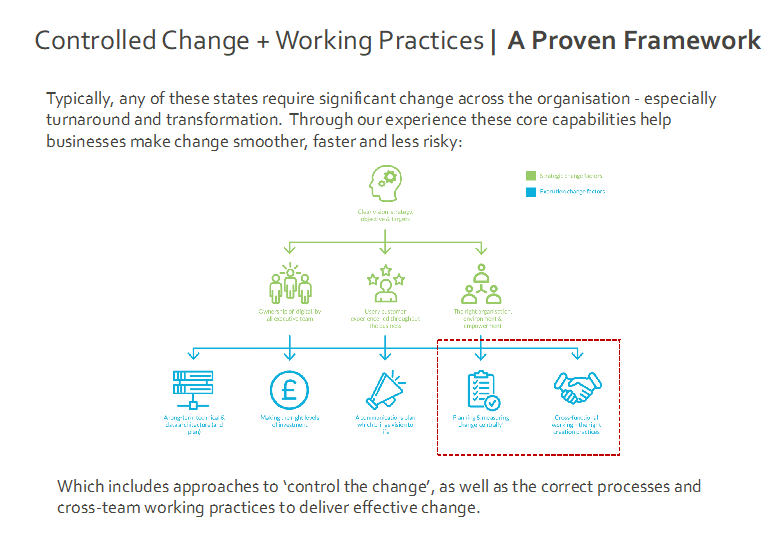
When we go and talk to organisations about transformation, typically we use this framework. We’ve got a top-level methodology which we operate to. We start with education about what digital is, then we give a direction of change through what we call digital evolution or our business transformation curve.
Then we’ve got a bunch of blueprints which are proven actionable ‘Elements’ at each functional state, at each stage, which will help in that change. But we also talk about the capabilities that you need to inject into your organisation to make that change smoother, faster and less risky.
Now, in some of the earlier webinars that we’ve done, I’ve gone through this in quite a lot of depth. But as you will see, there’s a red box around two of the five Elements, this is what we’re talking about today.
For most organisations it’s really a very important requirement to have a central planning function to control the program of change; get your creation processes right; and have cross functional working practices (e.g. IT and Marketing need to operate together).
This gives you an indication of all the things that you as organisations need to put into your business, if you’re going to go through a significant transformational stage. It starts with the ‘strategy and vision’ at the top, it then goes through cultural elements (green on slide), what we call ‘strategic factors’, and then into what we call to ‘executional factors’ (blue on slide) of which two of them we’re going to be talking about next.
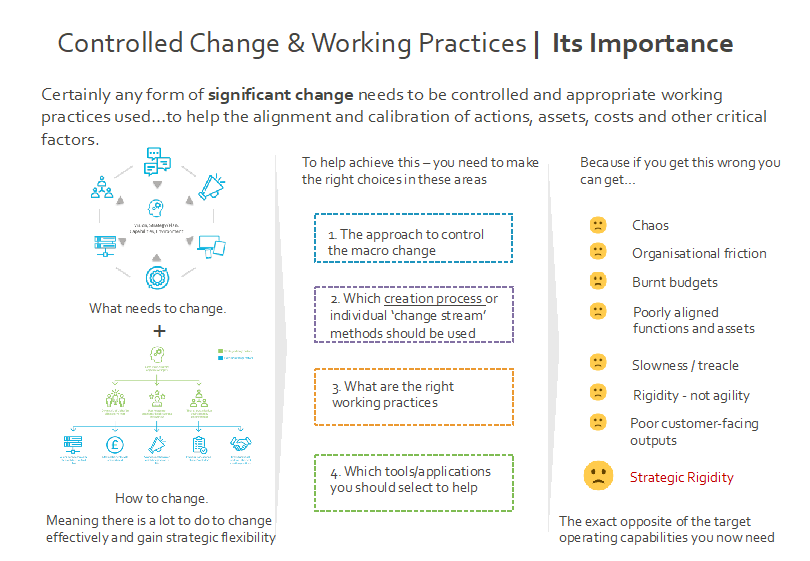
Why is it important to be able to control change in working practices? Well, if you going to have significant change, you need to be able to control it. You need to have people working together well. So you effectively align your actions, your assets, your costs and your criteria.
On the left hand side of the slide we’re looking at, this is everything that we’ve said today. You need to adapt your organisation, not only to do the right things for your customers and the environment, but secondly, you need to get the right degree of capabilities into your organisation. Skills…whatever it is, but actions to ensure that that change is smoother and faster. What it means on the left hand side of the slide, is that it’s just a lot to do!
To be able to achieve that you’ve got to make the right choices in four critical areas highlighted in the middle of the slide. Firstly, how you’re going to go about controlling that top level program, that macro program of change. Secondly, what you’re going to choose as your creation process so it gets delivered in the right way, on time and on budget using whatever KPIs you want.
The third one is how you go about creating the right working practices, the right collaboration between teams. The fourth one is there to help with all of the first three, what tools and systems should you be choosing to help?
If you make the wrong changes, you get the results on the right hand side of the slide. You can get chaos because you’re not controlling the program at the right level.
You can get organisational friction because people don’t like change (some do but often a lot of people don’t) and it can create organisational friction between people and that’s just unpleasant. If you go about it in the right way you can eliminate that. For me, that’s one of the most horrible things, when people start to go, ‘I just don’t want to do this anymore’, and it starts to go in the wrong direction.
You can also burn budgets very quickly if you have poorly aligned functions and assets and don’t do the right things out in the market. You get slowness. How many people in the audience here have heard “our organisation’s a bit like treacle, we just can’t get stuff done”?
You can get rigidity or “we can’t do that because we’ve always done it that way…”. Okay, but you shouldn’t do it that way anymore, because everything’s changing! You also get poor customer facing outputs and that’s a real impact to your customers and then ultimately to the organisation, then they don’t pay you as much anymore.
You broadly create strategic rigidity, you know, the opposite of that element I was talking about ‘strategic adaptability’. It’s the opposite of what you need to do. So, if you don’t get those things right in the middle, you often end with a non-optimised way of working in your business.
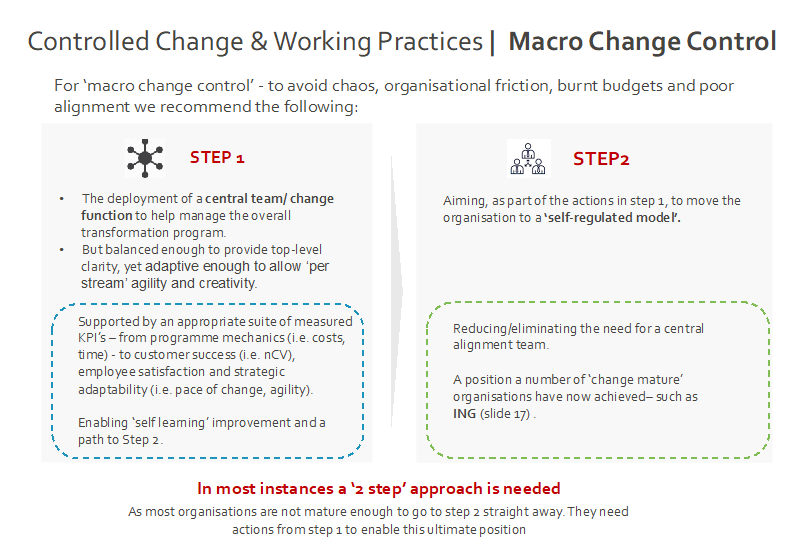
How do you control a big transformational program? There’s an interesting debate on this one but we see, for most organisations, that you need to go through a two-step process. For most organisations getting to what we would call the optimal way of working, the Step 2 target is hard.
Most organisations aren’t like ING! They have got to that state or pretty near to that state with what we would call a self-regulated model. You have to be practical and you have to put your hands up and say it’s probably going to take time and effort to go through Step 1, to enable approach towards Step 2.
For your Step 1 you need to put in place a central team or a change function. It doesn’t have to be huge. It’s a group who look, with the appropriate governance, to control that big degree of change. They align and calibrate, they ensure that teams work together and they operate to the right measurements.
Those measurements could be the normal stuff, such as budget controls, but you mustn’t lose sight of the fact that it also means customer success within it, or employee satisfaction, or strategic adaptability measurements. Through that change function, you’re trying to put the capabilities into the organisation to not only create what you’re doing, but to ensure as an organisation, you’ve moved more towards Step 2.
Now, it can be sad for the central change team if they are successful because if they create the right change and shape for the organisation they are then redundant. But actually, that’s a massive measure of success in what they’ve done to get to the Step 2, self-regulating model when you don’t need a central change team.
You’ve got the right working relationships between parts of the organisation to ensure it’s moving in a self-regulated way, in the right direction itself. Now, there are very, very few instances out there of this happening. Where it is happening it is incredibly powerful.
If you’re starting on a transformational journey, practically you need to start at Step 1 and the change teams job is to control the change and ultimately get the organisation to Step 2.
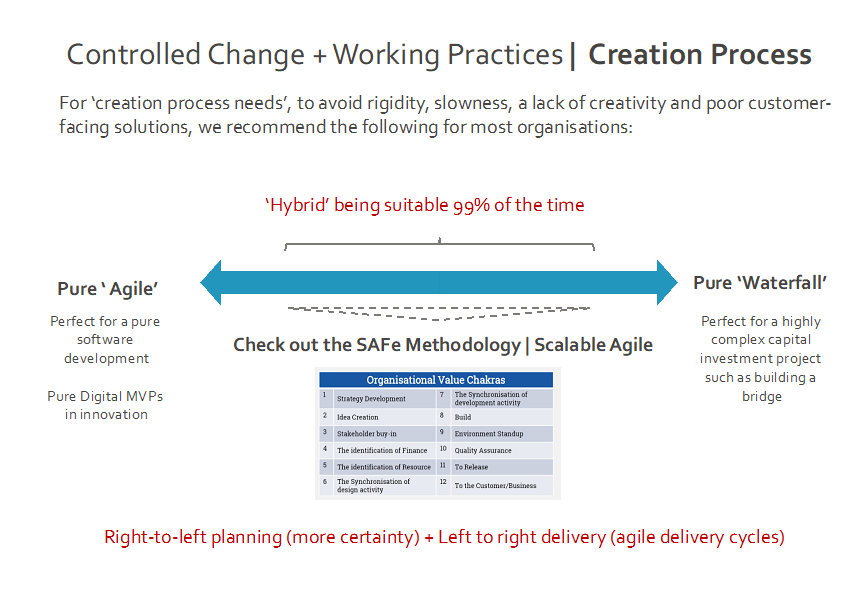
The next thing to ask is ‘What processes do we need to put into the business to help each stream create things?’ Often change is about creation. Now, I’m sure most people know about Agile and Waterfall.
Agile is really adaptive and effectively does fast sprints of delivery. Waterfall, often maligned because effectively it’s planned change with long delivery cycles, is very standardised and has a high degree of control and sequential delivery. You could say they are at two ends of the spectrum.
The issue about Agile for a lot of organisations is about what I call left to right delivery, but there’s no right to left framework or planning associated with it. Now, Agile was originally developed for the software development industry and that works really well. If you’re actually creating just a Web environment where you’re doing a software development interface then Agile works incredibly well.
Conversely, however, if you’re trying to create a billing system or a brand new technical environment or architecture, you probably need a degree of planning in that and Agile might not make it work together correctly in the calibration of all the bits. Waterfall is what you would use in that case. It’s suited for creating a big capital project, e.g. a new Hoover Dam, or something like that.
But for every other kind of transformational element, and also to give certainty to your CFO to a large extent, we recommend using a hybrid approach, which takes the best of Waterfall from a right to left planning perspective, but the best of Agile from left to right delivery perspective.This framework, which is gaining rapid popularity, is the SAFe methodology or scalable Agile.
Again, to the audience here, I strongly recommend if your organisation is going through significant change, and they need to adapt into your marketplace, have a good look at the SAFe methodology.
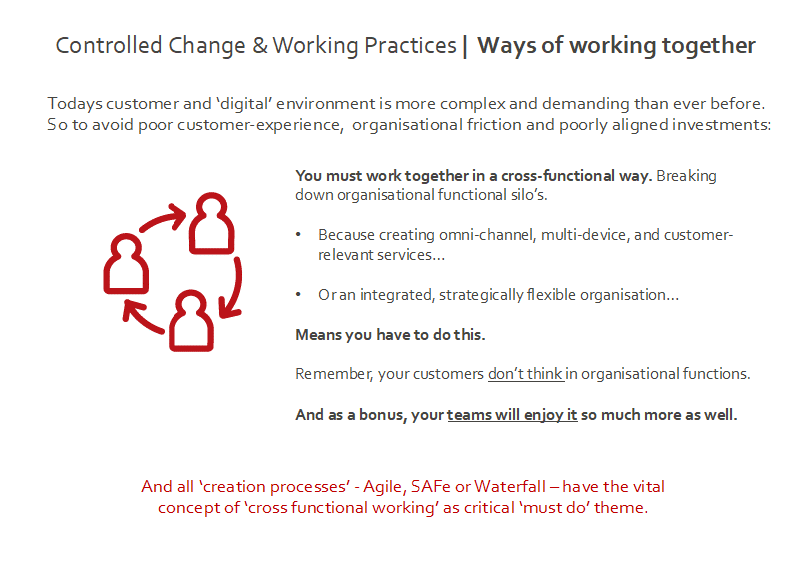
The other element is the ‘ways of working together’. Now, you’ve already heard that today’s customer and the digital environment is more complex than ever before. Complexity means that you’ve got to think, define and be able to work together to deliver it. If you don’t do that and you continue to operate in organisational silos what you get is a poor customer experience, organisational friction and poorly aligned investments.
From our experiences, we recommend that teams have to work together in a cross-functional way. You’ve got to break down the organisational silos that most companies have.
If you’re going to create an omni channel, multi-device and customer-relevant service, you can’t just do it in your departmental viewpoint. It’s not going to work. You can’t create the right go to market marketing message if the product doesn’t do what you say, or you can’t operationally support it, or if things go wrong you can’t fix it quickly enough.
You can’t operate in a silo if you are looking to be a strategically flexible or adaptable organisation because silos don’t work. So, organisations have to rethink what they do with their organisational functions.
If you look at self-adaptive, successful businesses they may have functions but they are loose functions and they operate together. They operate in a cross-functional way and they will bring people together to ensure that what is created for the customer and the business has all of the input necessary to bring all the elements together. That means getting the right people from individual teams to work together.
If you don’t do that, you’ll create solutions that may work correctly for each particular function but they are not all be joined up and importantly your customers think in a joined-up way! They don’t think like a vertical function, that’s the business and how it operates. Your customers think in a horizontal way and the business needs to create and deliver with the customer and the business needs in mind.
You can only do that by bringing the right skills and the right people from various functions together along that customer experience chain. Looking at awareness, to intent, to conversion, to use, to support, to advocacy and all other variants in between.
It’s also really important to recognise that, on the preceding slide, we talked about Agile, Waterfall and SAFe and at the heart of all of them is cross-functional working and the need for adaptability of relationships and those relationships working effectively.
So, regardless of the planning rigidity or the planning flexibility, or a step in between, all of them have got the idea of cross-functional working in creation (and during business as usual) at the heart of what they do. If you remember that slide where I talked about Step 2, this is absolutely how those mature organisations operate. It’s possibly the most important bit!
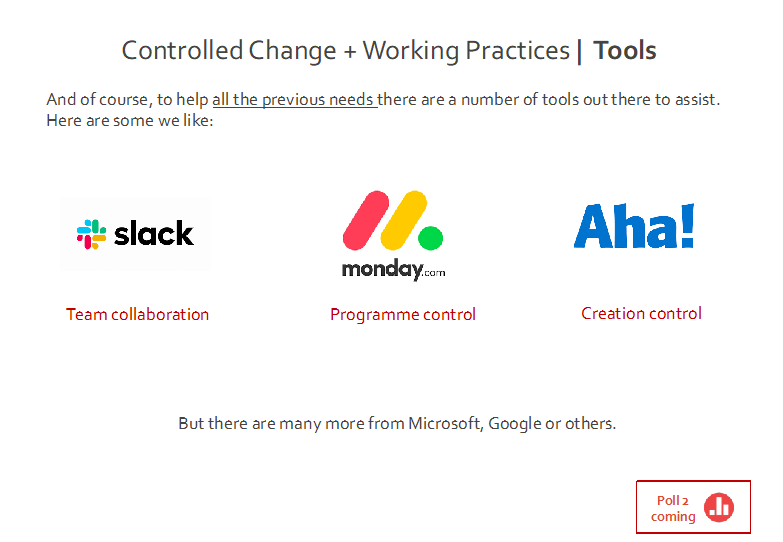
Obviously, there’s lots and lots of tools out there to help all of these top-level change creation processes to work together. There’s lots out there and of course, Microsoft and Google do a great suite. These are the just some of the ones we’ve looked at and quite like.
We often go into organisations and they may be missing team collaboration so we recommend taking a look at Slack, it’s really good. You can also use things like Trello for this too, same type of thing. However, we like Slack because of its interoperability with some of the other things that we’ve got on this slide here.
Another one that we use often for program control is Monday.com. It’s simple to use and it’s SAS based so everybody can collaborate into it. We liked it because it’s outcome-based. We often find things like Microsoft Project (and I’m not knocking Microsoft Project because it clearly does have a place) becomes very complex and it actually starts to rule the effort rather than the output.
We think Monday.com does a broadly similar job but it’s just easier. As it’s SAS orientated and has multi-team collaboration within it, it encourages that type of thing. Often Project can be output as a physical document and its version control gets quite difficult. With Monday.com you don’t have that.
Another one we like is Aha! From my background as a Product Director, I like doing proper Product Management. I’m very passionate about how you can control the product development and creation process. In my day, unfortunately, it used to be done by paper and email!
Aha! has got good processes to be able to help define things in an appropriate use case. It controls all the way through the process and it’s pretty adaptive. So if you work in a regulated environment, you can get regulatory approval for various inputs.
Again, it helps with that collaboration, but also underpinning that, brings clarity of what you’re going to do in the definition and controls it throughout the process. There’s very much a workflow for thought creation and collaboration and it’s really easy to use, massively powerful.
In addition to all the benefits these tools bring, they are pretty cheap to use as well. They’re all SAS based and they’re not going to break the bank. For really, really complex programs then maybe Monday.com is not appropriate but generally on the whole this a pretty good suite of products.
Clare, I think there’s another poll going to pop up. Is it is it possible you can run that one for me?
Clare Carroll: Sure, I’ll run that for you now.
Of the four core elements presented today, which do you think is the most important?
- Central team who can control and facilitate the macro level
- An appropriate change creation process or methodology that the business can follow
- Effective working relationships such as cross-functional working practices
- A strong set of tools to help control, encourage and enable
- Again, okay, be with more minutes, just two more seconds. So if there’s any more voting going to be done.
Please go ahead and vote, thank you.
Andrew Salmon: Okay, so, the trite answer to this is, they’re all important. The most important one in my humble opinion is the effective working relationships. It is at the core of what you need to do to get to that self-regulated environment.
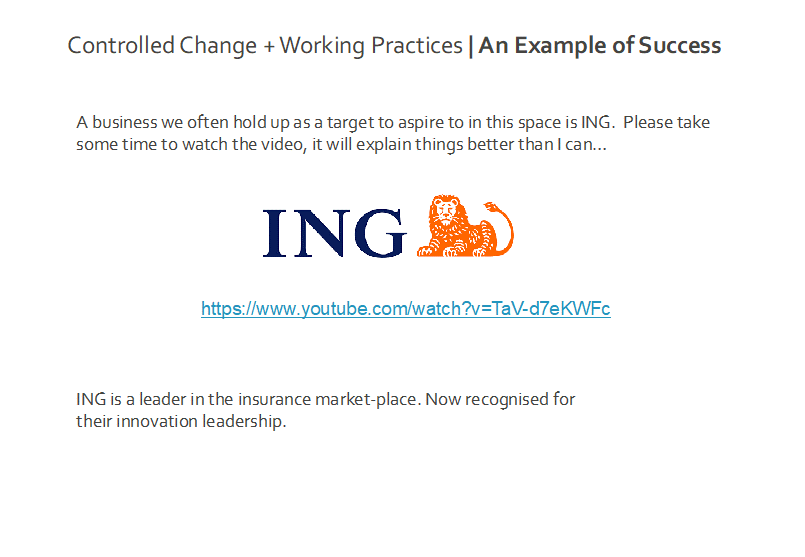
Finally, I have some examples of what I’ve been talking about. So I’m going to cheat a little bit today. Please go and have a look at this (video link on slide). This is actually in Belgium and is an example of that self-regulated mature state I was talking about.
We haven’t seen achieved very often but it’s massively powerful when it is done. Have a look at the video because it explains things far, far better than I can. It will provide you with a picture in your head of something to aspire to and achieve through the steps that we’ve been talking about today.
You’re not going to do it straight away, it took ING a while to get this done but they went about things in a very clear way. They’ve got absolutely the right capabilities to be strategically adaptable today in what they’ve done, at least in this division. I absolutely recommend that you have a look at the video.
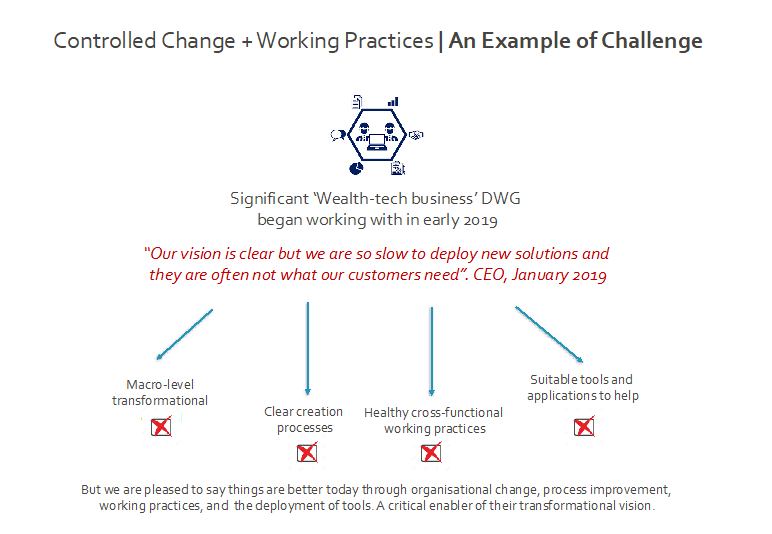
Here’s an example of practical change that we came up against early in 2019. This is a significant wealth tech business with 4 billion turnover, 1 trillion of assets under management, and has about 700-800 people in the organisation itself. So this isn’t a small business, this is a very complex business in a highly regulated environment. I’m not going to name the organisation but can share what the CEO said.
Obviously, one of the key things that we do when we go and talk to an organisation is to understand what are the pain points are. The CEO of this company is incredibly bright and very capable. He is a very entrepreneurial individual, an absolute force of nature.
Unfortunately, he just didn’t have the right understanding of his organisation needs. He had a really clear vision for where the business needed to be but his frustration was, I quote: “Our vision is really clear. I know where the business needs to go but we are so slow to deploy new things, and they’re often not what our customers need”.
Now, the characteristics were really quite straightforward because he didn’t have any macro-level transformational control within his business. Most of the work was done by a very core team of five people in the business. That wasn’t for change control; that was just five senior managers doing what they needed to do.
Nobody was looking or had planned what needed to happen to solve transformational change. There was no macro-control within the organisation. There was no roadmap so there was a vision but no path. That was a problem within the organisation itself.
Secondly, they didn’t have a clear creation process. They had no process! They didn’t even have a Waterfall process, right? Things magically kind of got done. It just kind of happened. There were some people in the organisation tasked with getting it done and by force of will they kind of got stuff done but there wasn’t a clear creation process within the business itself.
That was quite frustrating because clearly that was part of the reason why potentially things weren’t being developed in the right way, or they were slow. There wasn’t any healthy cross-functional working practices, there was really clear ‘siloing’. There was no product team working very elegantly with the IT team.
The IT team were very clear that their job was to keep the lights on and keep it functioning rather than adapting what needed to be done. There were no parts of the organisation moving that change program through. There were big chunky silos that didn’t get on together particularly well. It wasn’t very healthy working practices.
Once we discovered all of this we told the CEO and worked really hard at the start of the year, firstly on a bunch of other stuff and also, secondly, to help him solve these issues. Happy to say they are in a lot better state today than they were at the start of 2019 but it’s not too surprising that they were in that state. Back then, they didn’t have the organisational capabilities to ensure that they were moving in the right direction.
You’ll be really pleased to know guys, that’s me finished talking. Hopefully, what I’ve imparted made sense? I’m going to open up to Q&A!
Sophie Fraser: Right, we’ve got a question come in. What are the typical KPIs used to measure digital transformation?
Andrew Salmon: So let me help myself, okay? I’m going to go back to this slide (move back to Macro Change Control slide). So I think with most digital transformation, you’re going through change, right? So broadly, you can look at your customer and your functions and everything that you need to do.
On this slide, here are some examples of some of the core KPIs that a central change function should be looking at. You’re not just looking at cost and time, although important clearly, but they are what I would call mechanical things.
I know it’s important for the business to know whether you are going to deliver stuff on time and do it with the right cost control associated with it. It’s important for the CFO to see if you’re going to bankrupt the business! So are you delivering it in the right way? I always think is a program mechanic and is vital.
Other stuff you’ve got to look at is whether or not you are doing the right thing for your customer. Any organisation today needs to do the right thing as efficiently as possible. If you do that, you create profit and if it’s the right shape then you become quite valuable out in the marketplace.
But fundamentally, you’ve got to do the right thing for the customer. There are lots of ways to measure that. As an example, it could be net Customer Value (nCV) measurement. You could inject that as a way of customer satisfaction. There are lots of ways to have a look at it but that’s one example. You mustn’t lose track of the customer along the way.
Conversely, you must not lose track of the employee satisfaction because a big transformational program puts a strain on the organisation. You want to create not just the right thing for your customer and for your company (from a financial perspective) but you also want it be a really good place for your people to hang out.
So, your employee satisfaction and the way that they understand things, they know where you’re going and if it’s a happy place to work is super important as well. In today’s intellectual society it’s your people in your organisation, your talent, which gives you the edge. Technology also will, but technology does what it’s told. So employee satisfaction is really important as well.
Don’t forget, we’re trying to create a kind of strategic adaptability within the organisation; that capability. So there’s other stuff you want to do in terms of controlling and looking at whether you’re creating the capability of ‘pace of change’ and you’re doing things as agilely as possible.
You know there’s great examples of organisations today who can do online advertising really agilely. An event will happen and you get very clever advertising which pops out almost within hours. That’s the type of stuff that you need to be doing especially if you’re working in consumer markets. You’ve got to be able to measure those elements. So it’s a combination of all those things.
Are you doing the right thing for your customer? Are you doing the right thing for your people? Are you creating the right organisation, in terms of capabilities, to become ultimately self-regulating as in Step 2. Hopefully that answered your question.
Sophie Fraser: We have another very good question here. How do you balance a central team approach with adoption of change in the business as you go through the journey of self-regulated change?
Andrew Salmon: So how do you balance it? My viewpoint is this. Let’s go back to that slide I was talking about (move back to Macro Change Control slide). If you are a relatively immature organisation then set yourself up a central team with a target in the future to become a self-regulated environment.
You absolutely recognise that you do normal program controlling and everything on this slide, running to these KPIs etc., but you also need to create a strategically adaptive organisation.
It could be a stream of work within the program itself or it could be multiple streams of work. They have to run parallel and it has to be recognised that your transformational change is for your customer, the profitability of your business, your people, but also for how your organisation is going to be able to adapt into the future.
If we then go back to this slide (moves to slide: A Proven Framework) there are characteristics within that which are going to help that journey for you. This is the capability set (refers to slide: A Proven Framework) that you’re looking for those streams to do. These are going to enable you to be a strategically flexible organisation.
Those three (points to the middle green elements on the slide) start working together to actually enable change in the organisation. You bring your communication plan, your central change management and your cross functional working practices and creation processes together (blue elements), controlled through a program to deliver that digital transformational change.
As part of that, developing all these bits in the program (points to all the elements on the slide as a whole) you’re planning to ensure that you get to that self- regulating environment (Step 2). That’s your balance.
So your program not only delivers the tangible stuff for your customers and your organisation, but also builds in the capabilities you need to get to that self-regulating state. That, for me, is the way it is balanced and that’s how we advise companies.
If you’ve got a good central team, you can dial stuff up and dial stuff down, depending on the practicalities of the environment, the resources and time that the organisation has. Always, however, with a view to the market and what it’s demanding that your organisation needs to be.
Sophie Fraser: Thanks for that, Andrew. I think that just about wraps it up. There are no more open questions but thanks everyone for your participation today.
Andrew Salmon: Hopefully that was useful guys? As Sophie says, thank you very much for your time. Hopefully, we’ve imparted at least some useful information. As I always say, if anything else springs to mind or you need something verified, please feel free to get in contact with us. We’re very happy to try to help. Thank you very much, guys.
Article by channel:
Everything you need to know about Digital Transformation
The best articles, news and events direct to your inbox
Read more articles tagged: Collaboration, Featured, Organisational Design




